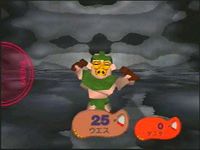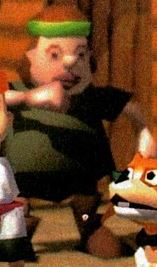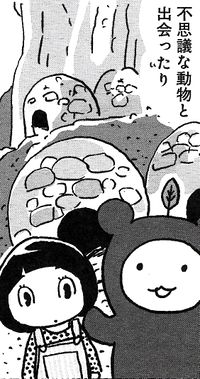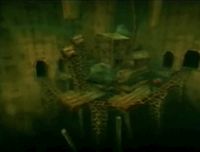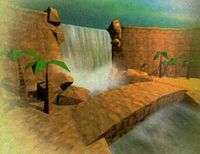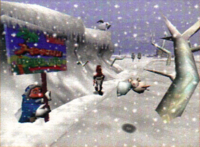🎊 Happy 2025, TCRF! 🎊
Prerelease:Mother 3/Differences
This is a sub-page of Prerelease:Mother 3.
| To do: Final touches!
|
Although the N64 version was far along around the time of its August 2000 cancellation, the GBA version made a lot of major changes to gameplay, presentation, and even story. There are many reasons for these changes: the change of development teams, the hardware of the GBA, and much more.
Contents
Story
The known major story changes or omissions from the N64 version to final release.
- The scenario in the N64 version was supposedly "darker" according to series creator Shigesato Itoi. This was because he was confronted with less options during the N64 version's development, and wanted to steer in a direction that would shock and upset the player. Additionally, he brought himself to tears while writing certain events of the game's plot.
- Benimaru Itoh said that the 64DD version would take place over a time period of ten years. However, this info was provided early in development at E3 1997, and it's unknown if this would've reflected the final N64 prototype after the story and scale was cut down.
- The story (according to the Spaceworld '99 booklet) originally began with the discovery of an unknown object in a nearby inlet. This is likely referring to the Kraken droppings that wash ashore in Great Scale Village, as depicted in Volume 10 of the MOTHER 3 Times.[1]
- The search for Flint's family in Chapter 1 was originally longer, spanning an entire day. On the night of the forest fire, the twins rode in a minecart to try and get their way out of the forest and back to the village, falling into the river. They were later found and participated in the search for Hinawa (as unused GBA data reveals they were originally unaware of her fate), which spanned across the next evening. In the final release, the minecart scene is cut and the twins are found moments before Hinawa's fate is revealed, with everything being simplified to one entire evening. [2]
- The subplot involving the Kraken attacking Great Scale Village was completely cut in the final release.
- The Fierce Pork Trooper was originally fought upon returning to Osohe Castle with Wess in Chapter 2. This was likely replaced by the Claymen Boss in the final version, but the presence of "Unfounded Revenge" as a Chapter 2 song in the sound player suggests this may have been a very late change.
- Flint had a much larger and active role in the second half of the story in the original N64 version. Originally he had a role in the White Ship story. According to Itoi, while writing the script for the GBA version, another development team member had just given birth to a child. Thus, this member felt a strong sense of sympathy for Flint, which affected Itoi and the manner in which he was writing the story, resulting in a lot of changes.[3]
- The ending in the N64 version was a lot more vague only to "betray the players", with Itoi even considering having the scene be entirely dialogueless. Although it did not change in summary, it was directed in a way which the characters questioned if there was any hope to begin with.[4]
- In particular, Itoi expressed the N64 version's ending as an "empty white void" that was "beyond tears", further describing the ending "as seeing the morning light after staying up through the pitch black of night". [5]
Gameplay
All the known gameplay omissions and changes from the N64 version to the final release.
- The N64 version had a currency mechanic from the beginning of the game, using large acorns you could pick up on the overworld. This was also the case late into development of the final game, but it was eventually removed.
- In the N64 version, you could select which character you wanted to lead the party by standing in front of them and pressing Z. This would perform a "baton pass", which is completely cut from the final release. In the GBA version, it is mandatory you only ever play as the protagonist of each chapter.
- In the N64 version, the player could jump and perform punches and kicks on the overworld. You could punch large enemies to hopefully knock them out, or kick small enemies to flip them over and make them vulnerable to further attacks. In the final release, jumping is entirely omitted save for a few key events, and overworld attacks exist only by running towards any enemies if any party members are more stronger.
- The N64 version had branching conversations in which the player could choose between various responses. In the final release, the only instance of this is limited to "Yes" or "No".
- NPCs would react to the player's actions (such as jumping) in the N64 version. NPCs do not react to your actions in the final release.
- Battles could not be initiated by simply making contact with the enemy like the previous Mother games or final release. In the N64 version, you had to stun them first by attacking them on the overworld, and then attacking them again to start the battle.
- Flipping over smaller enemies on the overworld would also give you the advantage in battle.
- The N64 version's battle system only allowed you to fight one opponent at a time, unlike the more free-form battle system of the first two games. This was reverted back to the normal battle system in the final GBA release.
- The player could clash into other characters and enemies, causing them to fall over and have sparks fly out. In the final release, this does not occur at all and making contact with an enemy will instantly instigate battle.
- Upon entering a battle, the text window would read "Battle with the (Enemy) Began!", unlike the series' standard "The (Enemy) Attacked!". This is most likely due to the non-hostile battles that were introduced in the N64 version. This was reverted to the standard opening battle text in the final release.
- As an enemy approached you, its respective battle theme would fade in audibly in certain areas in the overworld without music. In the final release, this was entirely omitted.[6]
- The original N64 version had physics, where a character could trip on the terrain or slide down slopes. Since the map is 2D in the final release, physics are completely omitted.
- The N64 version featured 3-on-3 battles, whereas the final release brings back the four-person battles found in Mother 2.
- When the enemy got the advantage on you, the screen would be angled in the N64 version. Whereas the enemy would be lying on the floor if you got the advantage. In the final release, the enemies instead all have back-facing sprites and no unique graphic for them having the advantage.
- You could dodge enemy attacks by pressing A with good timing during their animation in the N64 version, just like in Paper Mario. This mechanic was scrapped in the final game, likely due to the lack of attack animations.
- Originally, in the N64 version only one party member was ever active at a time, with a new mechanic where you could swap your playable character during battle by flicking the Control Stick left or right. If your active character was in danger, you could swap to a healthier character and let them endure the enemy's attack for that turn. In the final release, all four party members are active each turn like the previous games.
- A mechanic called "Speak" was in the N64 version, where the player could talk to the enemy to determine whether they could run from a fight or not. This mechanic was scrapped from the final release in favor of a standard run option.
- A stat called "Kindness" was present in the N64 version, possibly relating to your interactions with enemies. Although this stat does exist in the GBA version, all explicit references to it during gameplay were cut completely.[7]
- Lucas originally had an ability named "Call" where he could summon friendly animals to assist in battle. The only remnant of this in the final release is him whistling to summon the Dragos in the final cutscene of Chapter 3.
- Unlike the final release where music notes are displayed on screen to track your rhythm combos, nothing was displayed in the N64 version.
- PSI was originally substituted by a mysterious ability called "Magic", where the player had to charge a meter by absorbing the environment's magic in order to perform a Magic attack during battle. If overly charged, the character would be knocked out of commission for a round or two. The final release brings back the traditional PSI system from Mother 1 and 2.
- Similar to the previous game, if your guts were high enough, your player character could endure a mortal hit with only 1 HP remaining in the N64 version. In the final release, the guts status is completely omitted.
- As seen in the Spaceworld '99 demo, the text window after finishing a battle would read "(Character) learned something important from this battle!", instead of displaying EXP growth. This however was likely a restriction of the demo, as you couldn't level up your character or use items.
- The Pork Bean was originally available to the player in areas outside of Death Desert and the Highway. Additionally, ramming the Pork Bean into a wall would cause the playable character to fly out of it. This does not occur in the final release.
- Lucas could use the Dragos as transport around the overworld in the N64 version. It is not possible to mount them in the final release, let alone ride them around.
Music
- "Bon Voyage, Amigo"'s presence in the N64 version was confirmed by multiple magazines during the game's development; if it would have been different between the two versions is unknown.
- Before the "Love Theme" was composed in 2005, MOTHER 3's original theme was "His Highness Theme", which is is still used heavily in the final game.
- The presence of "Piggy Guys" in the N64 version can be seen in the Spaceworld '97 trailer, where Flint Rythym-Combos a Pigmask Sergeant to the beat of the track; it is unknown whether it would have been different between the two versions.
- "White (Owner's Recommendation)" was written originally as the theme for Snowcap Mountain, but was replaced by "Snowman" during GBA's development.
- "Samba de Combo" was confirmed by Sakai on Twitter in 2019.
- Many songs, such as "Run My Dog, Run!", "Confusion", "Huh?", "Open Sesame Oil!", "Open Sesame Tofu!, "Monkey's Love Song", & "The Peddler's Grand
Speech", can be confirmed to exist for both versions. Sakai stated that for cutscenes, the music was composed after the visuals, and he's gone on record saying that he tried to reuse as much music as possible.
N64-exclusive Tracks
- A Theme for Tazmily Village was composed & used in the N64 version, alongside its leitmotif being used in multiple different tracks. After the switch to GBA, attempts were made to rearrange the track to fit the GBA's smaller screen, but were abandoned. After this, multiple songs in the GBA version would receive the leitmotif as well, such as "Master Porky's Theme".[8]
- An easier variant of the track "Etude for Ghosts" was released on the day of cancellation. Its harder variant is used in the final game, while the easy one is left unused.
- An unused track present in the GBA version's files, referred to as "Fetch, My Dog, Fetch!", has been found to match the existing footage of the N64 version's scrapped minecart sequence, seen in the Spaceworld '99 trailer; based on this, it is possible that the song would have been present in the N64 version as the track playing during the sequence. [9]
GBA-exclusive Tracks
- As revealed by a Nintendo Dream interview with Itoi in July 2006, the GBA version's final "Love Theme" track wasn't composed until late in development, around four months before the game's eventual release; the game's original main theme, going as far back as (supposedly) the development for the N64 version, was the sad rendition of "His Highness' Theme", or the "Pigmask Theme". This track, which would have possibly been in the N64 version, can be found unused in the files of the GBA version.
- Both "Mr. Batty's Twist" & "Porky's Porkies" were written sometime in 2005 after Itoi mentioned Hiromi Go's "Yoroshiku Kochiai" in "Today's Darling", being the basis for both song's melodies.
- "Snowman" was added after Sakai remembered that the track was commonly used in both MOTHER & MOTHER 2 for snow areas, having previously written "White" instead.
- "Burst-In Rock 'n' Roll" likely didn't exist until development of the GBA version, as unused data suggests that Flint, Andonuts, & Wess were supposed to arrive to help instead.
Battle System
Menu Options
| N64 Version | GBA Version |
|---|---|
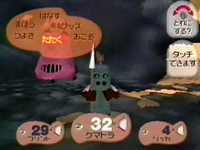
|
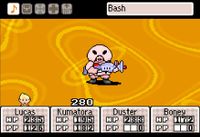
|
- In the N64 version, the battle options are Bash, Speak, Goods, Check, Defend, Magic, and Character Skill.
- In the GBA version, the battle options are Bash, Goods, Character Skill, Defend, and Run.
Hit Graphics
| N64 Version | GBA Version |
|---|---|

|
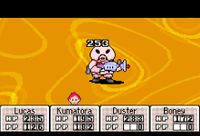
|
- In the N64 version, a yellow spark flies as you hit an enemy. All damage is displayed in the text box, just like Mother 2.
- In the GBA version, the enemy sprite flinches and the amount of total damage is displayed as an animated graphic on screen.
Sound Battle
| N64 Version | GBA Version |
|---|---|
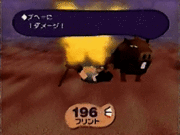
|
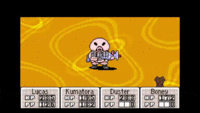
|
- In the N64 version, the enemy falls flat on the ground as you combo them. The hits are displayed with a blue flash and flame. Each hit is counted by the text box above.
- In the GBA version, a counter flies off the enemy themselves, as music notes display on screen each time you make contact with the enemy. A small white spark is also seen as you hit the enemy.
Magic/PSI Graphics
| N64 Version | GBA Version |
|---|---|

|
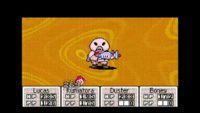
|
- The Magic attacks in the N64 version encapsulate the entire screen when performed. The screen slowly dimmers as the magic animations fade in, before the screen flashes white a couple times.
- Comparatively, the PSI attack graphics in the final release are far more tame. The screen dimmers slightly, with some gentle flashing filters before the attack animation plays on screen. The PSI animations also now resemble Mother 2.
Enemy Defeat
| N64 Version | GBA Version |
|---|---|
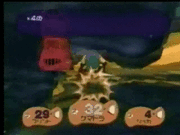
|
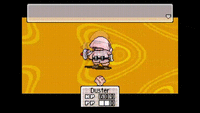
|
- Defeating an enemy in the N64 version will cause it to spin and fly away out of bounds.
- In the GBA version, the enemy sprite flies away in a vectorized manner. A yellow spark very similar to the N64 version is also seen when hitting the enemy.
Surprise Attack
| N64 Version | GBA Version |
|---|---|
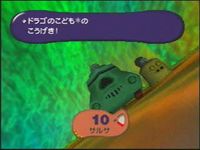
|

|
- The screen was angled to the right when the enemy got a surprise attack on you in the N64 version, presumably representing a state of being dazed.
- In the GBA version, there is no unique graphic for the enemy having an advantage on you.
Character Damage Graphics
| High HP | Medium HP | Zero HP |
|---|---|---|

|

|
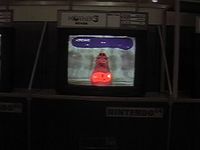
|
- In the N64 version, as you took damage the character window progressively changed from light brown, to orange, to red when their HP reached 0.
Enemy Turn
- In the N64 version, a red "enemy" graphic was displayed on the left side of the screen to indicate when it was the enemy's turn. No such indicator exists in the final release.
Characters
| To do: Provide more info on any characters who require it. |
Characters who received changes over time, from small identity changes, physical changes, or even their significance in the story.
Lucas
| N64 Version Pre-Timeskip | N64 Version Post-Timeskip | GBA Version Pre-Timeskip | GBA Version Post-Timeskip |
|---|---|---|---|
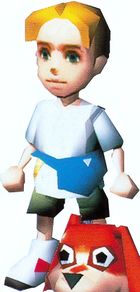
|
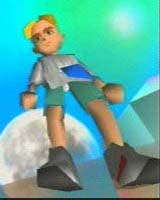
|

|

|
While Lucas did not receive any drastic identity changes between the N64 and GBA versions, his look changed significantly over the course of Mother 3 's development, eventually bearing somewhat of a resemblance to the Mother series' previous protagonists.
Claus
| N64 Version Pre-Timeskip | N64 Version Post-Timeskip | GBA Version Pre-Timeskip | GBA Version Post-Timeskip |
|---|---|---|---|
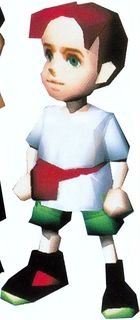
|
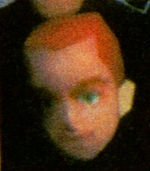
|

|

|
Claus originally had a larger role in the N64 version, riding with Lucas in a minecart to escape the Sunshine Forest fire and accompanying his family during their search for Hinawa during Chapter 1; however, his overall significance in the game is unknown. In the GBA version, both the minecart sequence and the majority of Chapter 1 were cut, reducing Claus' early-chapter significance in the final version.
Flint
| N64 Version | GBA Version |
|---|---|
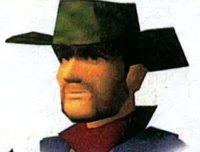
|
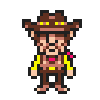
|
In the N64 version (and up until very late in development), Flint had a much larger role than that of the final release. Originally, he accompanied Lucas on his journey in the latter half of the game, continuing his search for Claus along the way. In the original game, Flint was going to have a role in the white ship story. In the final game, the roles for only Duster, Kumatora, and Wess are mentioned. No one else has their initial roles revealed.
Boney
| N64 Version | GBA Version |
|---|---|
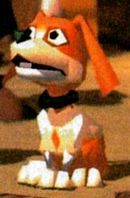
|

|
Hinawa
| N64 Version | GBA Version |
|---|---|

|

|
Hinawa received no significant identity changes between the N64 version and the GBA version; despite this, unused GBA data indicates she may have been a party member at some point during the game. A woman with her hair tied back bearing a resemblance to Hinawa also appears in the Spaceworld '97 cast photo, though the reason or significance of this is unknown.
Duster
| N64 Version | N64 Version D.C.M.C. Outfit | GBA Version | GBA Version D.C.M.C. Outfit |
|---|---|---|---|

|

|

|

|
Duster stayed consistent between the two versions, with Chapter 2 still being dedicated to him and being part of the D.C.M.C.. The biggest change between the two versions is the addition of Wall Staples and Rope Snake, with the latter originally being plain ol' rope according to unused GBA graphics. Also, his D.C.M.C. outfit originally had a beret instead of a wig.
Kumatora
| N64 Version Pre-Timeskip | N64 Version Post-Timeskip | GBA Version | GBA Version Unused Post-Timeskip |
|---|---|---|---|
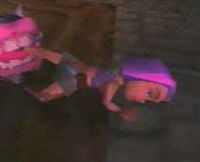
|
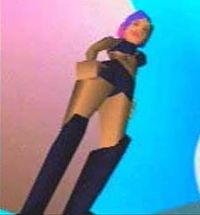
|
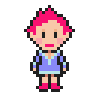
|

|
Kumatora's role was changed drastically, although much isn't known about it. In the N64 version (and unused early GBA data), she had different outfits pre- and post-timeskip. Originally, Kumatora seemed to have somewhat of a smaller role, since Flint accompanied Lucas throughout the game. In the final release, Kumatora was given a larger role as Flint's was reduced.
Wess
| N64 Version | GBA Version |
|---|---|
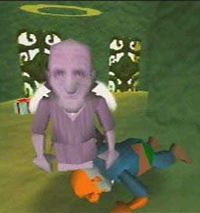
|
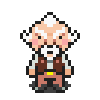
|
Wess was originally a playable party member. He can be seen leading the party in a battle against the Fierce Pork Trooper in a screenshot from the N64 version. This was also the case in the GBA version, very late into development (so late that Itoi himself forgot he was cut). [10]
Salsa
| N64 Version | GBA Version |
|---|---|
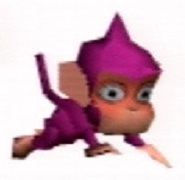
|

|
Samba
| N64 Version | GBA Version |
|---|---|

|

|
Alec
Little is known about Alec's role in the N64 version, as his presence in the N64 version was unfounded until 2022, when an anonymous developer for the N64 version revealed to MOTHER FOREVER that he was indeed present in the game at the time of the N64 version’s cancellation. [11]
Lighter and Fuel
| N64 Version Lighter | GBA Version Lighter | N64 Version Fuel | GBA Version Fuel |
|---|---|---|---|
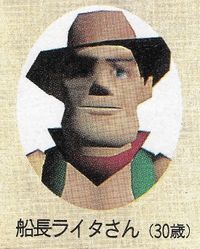
|
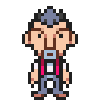
|
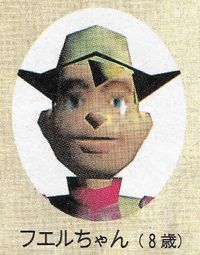
|
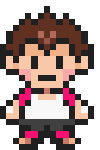
|
Lighter and Fuel both originally had much larger roles. Their own personal tragedies were explored deeper, with the loss of Lighter's wife Tobacco happening before the start of the game during a fishing trip gone wrong. The two-headed Kraken of Great Scale Village was also going to attempt to finish the job by devouring Fuel, as seen in Spaceworld '97 footage. Alas, these plotlines were cut, leaving only the loss of their home during the forest fire remaining, although unused GBA dialogue from Chapter 7 alludes that they still had a larger role at one point, with Lighter telling Lucas they "tried all I could to protect Tazmily until the end."
Ionia
| N64 Version | GBA Version |
|---|---|
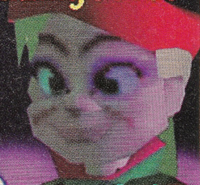
|
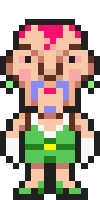
|
Although still a Magypsy, Ionia's role in the story largely changed between versions. Originally, Ionia was disguised as a fortune teller within Tazmily in the N64 version. Whereas in the final release, Ionia lives a more isolated Magypsy life up in Mt. Oriander.
Fassad
| N64 Version | GBA Version |
|---|---|
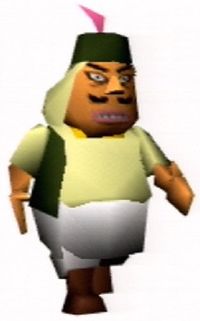
|

|
Mayor Pusher
| N64 Version | GBA Version |
|---|---|

|

|
Originally, Mayor Pusher was named "P.K. Pirkle" (ピカピカール). In the N64 version, he had a much kinder and humble personality, being respected among the villagers of Tazmily. Along with the name change, he became more of a prissy personality with a large ego. He also had a larger family in N64, consisting of Caroline, Angie, and a character resembling Mapson in addition to Ollie, Elmore, and Sebastian. In the final release Caroline, Angie, and Mapson are never stated to be related to Mayor Pusher.
Elmore
| N64 Version | GBA Version |
|---|---|
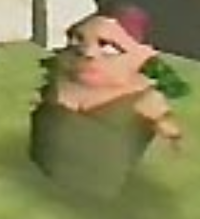
|

|
Nana
| N64 Version | GBA Version |
|---|---|
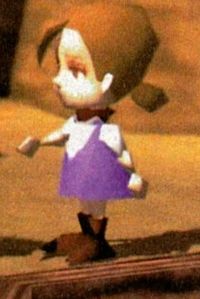
|

|
It seems Nana originally had somewhat of a larger presence in the story. The disappearance of her father seemed to tie into the rifts being torn between Tazmily villagers and their families, upon the arrival of the Pigmask Army. Nana's backstory is omitted entirely in the final release, with her lacking any sort of arc throughout the game.
Scamp
| N64 Version | GBA Version |
|---|---|

|
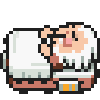
|
In the original Japanese release of Mother 3, Scamp lacks a proper name, only being called "Elder" (ちょうろう). Whereas in the original N64 version, he had an actual name - "Grandpa Syd" (じいさんてシド).
Alle
| N64 Version | GBA Version |
|---|---|
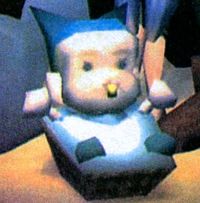
|

|
Alle was originally a newborn male. Not only did they become a toddler, but their gender was changed to female as well in the final release.
Ed
| N64 Version | GBA Version |
|---|---|
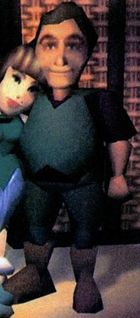
|

|
Nan
| N64 Version | GBA Version |
|---|---|
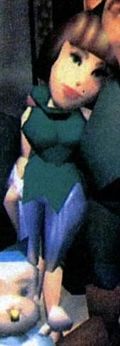
|

|
Richie and Nichol
| N64 Version Richie | GBA Version Richie | N64 Version Nichol | GBA Version Nichol |
|---|---|---|---|
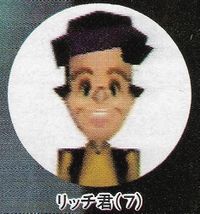
|
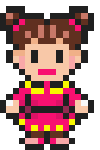
|
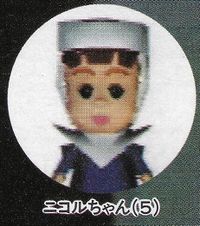
|

|
In the N64 version, Richie was the male sibling, while Nichol was female. In the final release, their names are reversed. It is unknown if this was intentional or simply a mistake that happened along the way. They were also involved in a subplot depicted by Volume 10 of the MOTHER 3 Times involving them being rescued by a Drago-like creature in the Sunshine Forest, although this was cut in the final version.
Isaac
| N64 Version | GBA Version |
|---|---|

|

|
In the N64 version, Isaac would have come across a crop circle while picking mushrooms in the Sunshine Forest. He would have also played a larger role in comforting Flint after the loss of Hinawa, stating to him, "Your own life's become more important now..." [12] This and his discovery of the crop circle are completely omitted in the GBA version.
Jonel
| N64 Version | GBA Version |
|---|---|
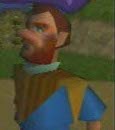
|

|
Jonel's role was more prominent in the N64 version, as unused GBA data shows that he was originally supposed to reveal Hinawa's death to Flint, instead of Bronson in the final version.
Bronson
| N64 Version | GBA Version |
|---|---|
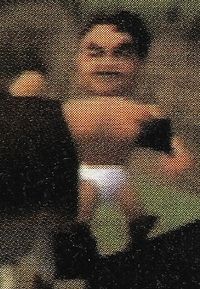
|

|
Bronson's role would have been larger in the N64 version, as unused GBA data indicates he would have been a playable party member in the game, which was ultimately scrapped in the final version. Bronson would most likely have been playable somewhere in Chapter 1, possibly replacing Thomas as Flint's accompanying party member during the Sunshine Forest fire.
Butch
| N64 Version | GBA Version |
|---|---|
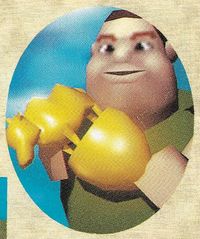
|

|
Lisa
| N64 Version | GBA Version |
|---|---|
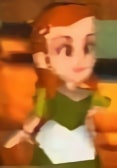
|

|
Lisa's role went unchanged between the N64 version and the GBA version, though she is more ditzy and scatter-brained in the N64 version; in the GBA version, she is more level-headed and sensible, although she is prone to gossip. Although she still works at Thomas's General Store, the connection between her and Thomas wasn't explicity stated.
Thomas
| N64 Version | GBA Version |
|---|---|
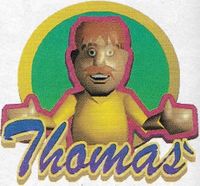
|

|
Thomas's role stayed fairly consistent between both versions, but would have played a smaller role in the N64 version; unused GBA data indicates that Bronson would have taken his place as a playable character in the Sunshine Forest fire, rather than Thomas like in the final version. There is also no mention of him being related to Lisa, Richie, and Nichol in the N64 version.
Jackie
| N64 Version | GBA Version |
|---|---|
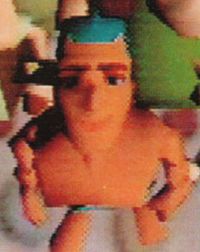
|

|
Jackie's role was changed somewhat in the N64 version, showing him and Bronson rescuing Lighter from under a collapsed tree log during the Sunshine Forest fire; in the final version, he is shown to be idling near Yado Inn instead.
Nippolyte
| N64 Version | GBA Version |
|---|---|
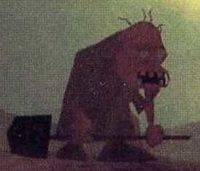
|

|
While there seems to be no difference in Nippolyte's role between the N64 version and the GBA version, Nippolyte bears a striking resemblance to Dampé from The Legend of Zelda: Ocarina of Time in the N64 version, as opposed to the GBA version where these similarities are completely absent.
Leder
| N64 Version | GBA Version |
|---|---|
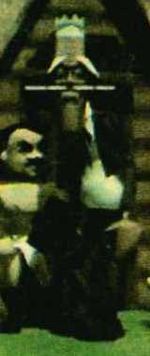
|

|
Dr. Andonuts
| N64 Version | GBA Version |
|---|---|
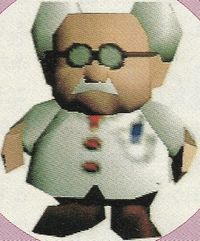
|

|
Mr. Saturn
| N64 Version | GBA Version |
|---|---|
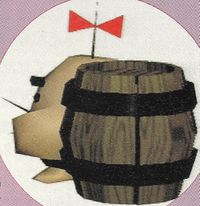
|

|
Save Frog
| N64 Version | GBA Version |
|---|---|
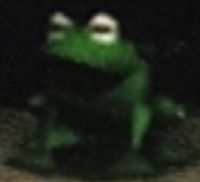
|

|
D.C.M.C.
| N64 Version | GBA Version |
|---|---|

|

|
The D.C.M.C. had numerous changes between the N64 and final release. Not only did all of them originally have last names (with only Shimmy Zmizz's making the final cut), but most of their roles were swapped around:
- Baccio "Trumpman" was originally the sax player in the N64 version, originally having matching outfits with Shimmy Zmizz. In the final, he plays the drums.
- Magic "Zildjian" (whose real name was "Rodrigo Rodriguez" in the N64 version, revealing Magic to be a stage name) was originally the drummer. In the final release, he plays the guitar.
- O.J. "Hagii" was originally the guitarist, rocking out shirtless. He became the sax player instead in the final release.
- Shimmy Zmizz was originally the band leader instead of O.J., along with having matching outfits with Baccio. He is the keyboardist in both versions.
They originally all had unique outfits, with Baccio and Shimmy resembling Lucky and Gorgeous from Mother 2 respectively. In the final, they all wear matching pink outfits.
Dragos
| N64 Version | GBA Version |
|---|---|
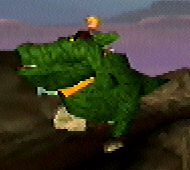
|

|
In the N64 version, they could be ridden upon by Lucas in the game's overworld and could be summoned into battle by Lucas using his "Call" ability. Both of these features were cut in the GBA version.
Pigmasks
The Pigmasks originally were designed more as armor-clad knights wielding spears and swords, tying into the whole "Pig King" thematic. In the final release, they are more stormtrooper-inspired, complete with button-up soldier uniforms and guns instead of spears. Their ranks also completely changed between versions.
N64 Version:
| Pigmask Private | Pigmask Sergeant | Pigmask Lieutenant |
|---|---|---|
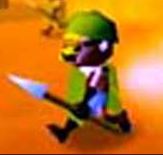
|
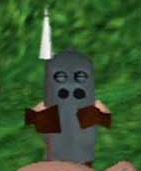
|
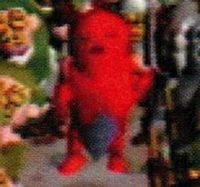
|
- The second-lowest rank in the N64 version was "Pigmask Private".
- The standard ranking was "Pigmask Sergeant".
- The highest ranking was "Pigmask Lieutenant".
GBA Version:
| Pigmask (Formerly Sergeant) | Pigmask Colonel |
|---|---|
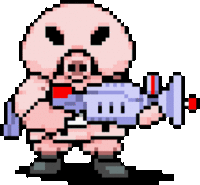
|
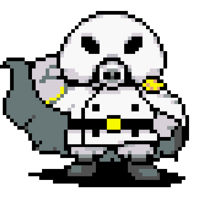
|
- The "Sergeant" moniker is dropped for the standard Pigmasks in the final release, with all rankings below them being cut completely.
- The highest ranking was changed from lieutenant to "Colonel".
Claymen
| N64 Version | GBA Version |
|---|---|
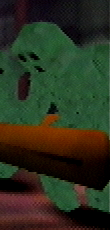
|

|
In the N64 version, the claymen would have more prominent roles; one clayman in particular would have escaped his enslavement by surfacing in a river in the Shimedori Forest. This incident was cut completely in the final GBA version, and the claymen were redesigned by Itoi into their final form (even though he was never quite satisfied with their design throughout MOTHER 3 's development [4]).
Mecha Drago
| N64 Version | GBA Version |
|---|---|
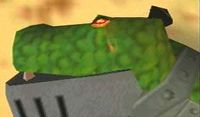
|

|
Cut Characters
Many characters were cut between versions, with them only being referenced in Dengeki's MOTHER 3 Times or by the developers themselves.
Tobacco
Tobacco, 28 years old, was the wife of Lighter and mother of Fuel. During a family fishing trip heading south, their ship, the Hatemi Maru, seemed to have been attacked by a large creature. While the other two were found and recovered, Tobacco was still missing. In the GBA version, there is no reference to Tobacco whatsoever, leaving Lighter the only parent of Fuel.
Bar
Bar was Butch's 70-year-old grandmother, known for knitting sweaters for all the villagers. In the GBA version, she is completely missing.
Mr. Chemli
Mr. Chemli was a 70-year-old resident of Great Scale Village, who had found the mysterious brown substance at Great Scale's Cove. In the GBA version, he is completely missing, probably due to Great Scale's downscale to a beach instead of its own village.
Papa
Probably the most well-known of the cut characters, Papa was a 40-year-old former sailor who lived in Tazmily Village with his 12-year-old daughter Nana. A year before the story of the game, he left on one of his sudden voyages, never coming back. In the GBA version, there is no reference of Papa whatsoever, leaving Nana as the only child in-game to not have any parents or family members.
Carefree Guy
The Carefree Guy was an unknown resident of Tazmily Village who mysteriously appeared in the village one day without any explanation. His resemblance to the Hippie enemies from the first two Mother games greatly unsettled the local villagers, causing curfews, strict social behaviors, and even investigative headquarters to be implemented in the village; his role seemed to be In the GBA version, he and any mention of him is completely missing from the final game.
Yottore-san
Yottore-san (よっとれさん) were a new species of characters set to appear in the N64 version of Mother 3. It is unknown why they were not carried over into the final game, despite once being alluded to by Benimaru Itoh: "...In addition to Mr. Saturn, there are other characters bound to make you cry. Mr. Saturn was originally created from Itoi-san's doodling, and these new crying characters were born from that as well. It'll spoil the fun if I say too much, so I won't reveal more about it. But, I believe these are characters with a personality just like Itoi."
Fans first received a glimpse at these cut characters from the release of the Pollyanna MOTHER Comic in June 2020. N64 Mother 3 enemy designer Toshinao Aoki, who wrote and drew the comic, confirmed these were characters he designed for the game.
Locations
While still familiar, most locations in Mother 3 differ in some capacity between the N64 and GBA versions.
Tazmily Square
| N64 Version | GBA Version |
|---|---|
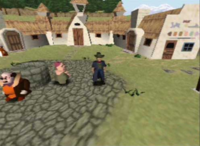
|
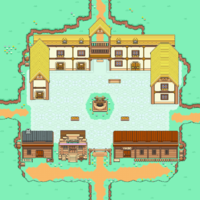
|
- According to Volume 13 of the MOTHER 3 Times, the square in the N64 version was called "Idobata Square" (イドバタ広場), which roughly translates to "Wellside Square". The well is surrounded by a stone pattern, with grass covering the rest of the map. On the right side, the General Store can be found.
- In the final release, the square has no specific name of its own. Much of the original N64 map is flipped in the GBA version - the grass and stone patterns have been flipped, and the General Store is moved to the left side of the map as opposed to the right.
Tazmily Square (Post-Timeskip)
| N64 Version | GBA Version |
|---|---|
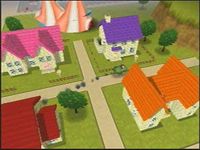
|
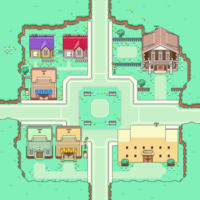
|
- In the N64 version, Tazmily Village bears more of a resemblance to Onett from Mother 2, with buildings closely resembling Ness' and Porky's homes north of Onett. A large tent similar to the ones found in Threed can be seen in the background, and Pork Beans could be used as vehicles within the town's roads.
- In the GBA version, the similarities to Onett and Threed were either made less obvious or completely removed, and there is no option to drive Pork Beans within Tazmily in the final version.
Thomas' Bazaar
| N64 Version | GBA Version |
|---|---|

|
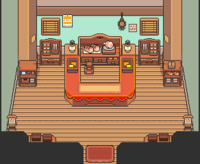
|
- In the GBA version, Thomas's Bazaar is more ornate, being decorated with bookcases and shelfs like a typical store. In the N64 version, the bazaar (known as Thomas's General Store during the N64 version's development) is decorated with barrels and tools, like a typical toolshed.
- Additionally, Lisa and an unnamed NPC also run the store in the N64 version alongside Thomas (and possibly Mike).
Mayor Pusher's House
| N64 Version | GBA Version |
|---|---|
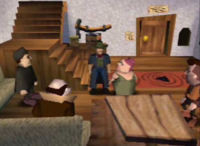
|
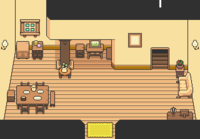
|
- In the N64 version, the interior of Mayor Pirkle's house is very compact and minimalistic in design, showing a large stairwell close to the living room area and the front door. The location of Pirkle's manor is also located some way from Idobata Square, up on a hilltop. [13]
- In the GBA version, Pusher's house is relocated to the main square of Tazmily Village, and the building's interior is more open than in the N64 version.
Yado Inn
| N64 Version | GBA Version |
|---|---|
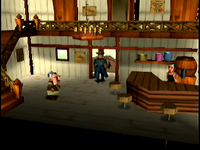
|

|
- In the N64 version, Yado Inn's interior is more constrained and less open than the GBA version, and the inn's structure is that of a two-story building.
- In the final GBA version, the inn's interior is more open and expansive, and the inn's structure is that of a one-story building.
Tazmily Crossroads
| N64 Version | GBA Version |
|---|---|
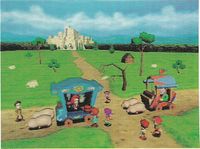
|
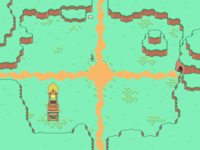
|
- In the N64 version, the crossroads lead to Sunset Cemetery to the east, and the mountains (called グレートロック, or "Great Rock" in the N64 version) to the north. The location to the west is unknown.
- In the final release, the Sunset Cemetery is changed to the northern path. East now leads to the train tracks, with the mountains (renamed "Orishimo Mountain", or "Mt. Oriander" in the fan translation) only being accessible through the Sunshine Forest, which is located west of the crossroads.
Sunshine Forest
| N64 Version | Early GBA Version | GBA Version |
|---|---|---|
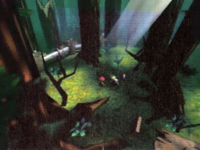
|
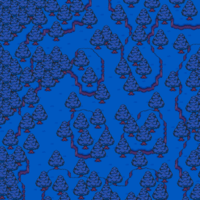
|
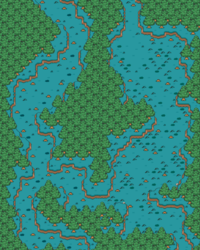
|
- The Sunshine Forest was vast and open in the N64 version, featuring sunbeams that would illuminate the player's path. Throughout the forest, a mysterious pipeline could be found.
- In the earlier iterations for the GBA version, while more condensed, the Sunshine Forest was still somewhat open with a more maze-like structure. This early map is still used in the introductory "F-F-Fire!" cutscene for Chapter 1, strangely enough.
- In the final release, the Sunshine Forest features a far more narrow, straightforward map. The sunbeams and pipeline from the N64 era are also gone.
Murki Cave
| N64 Version | GBA Version |
|---|---|
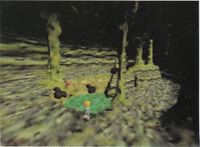
|

|
- In the N64 version, this area was named "Unlost Cave" (迷えない洞窟). It was described as the first cave the player visits in the game, which was filled with bats and impossible to get lost in. It was dark with a very limited field of view, having wavy greenish-grey textures with mushrooms everywhere. A hot spring is also present in the cave as seen next to Lucas.
- It's very likely this became the Murki Cave (or in the Japanese version, バタマ・ダンジョン, translated to "Bumpa Pass") Flint and Alec visit in Chapter 1. As it's also nearly impossible to get lost being linear in design, with Alec directing the player at every turn. Its name is never mentioned in the final release, and is much darker with a small spotlight on the player. However, its wavy green walls are very similar to the images seen of the N64 version. The cave is also inhabited with moles and Crag Lizards instead of bats, with the hot spring also having been removed.
Sunset Cemetery
| N64 Version | GBA Version |
|---|---|
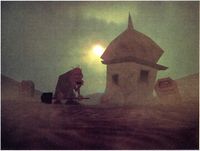
|
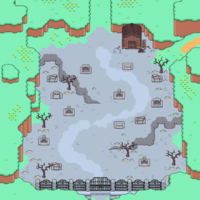
|
- In the N64 version, the Sunset Cemetery is more expansive and open, featuring rocky cliff-sides and a more hilly terrain. In the GBA version, the Sunset Cemetery is mostly contained within a portion of the surrounding Tazmily area, with the hilly terrain and rocky cliff-sides being nearly completely absent.
- According to unused GBA data, Hinawa's grave would have been placed within the cemetery grounds, rather than its own dedicated hilltop like in the final version.
Osohe Castle
| N64 Version | GBA Version |
|---|---|
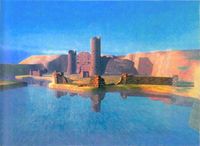
|

|
- Osohe Castle had a couple of fortified towers in the N64 version, and a shed can be seen in the middle of the courtyard. No drawbridge seems to exist, although you can see where the two pieces of land would connect just south of the castle.
- In the final release, Osohe Castle gained a balcony up top (where Duster first enters the castle from). The shed that was in the N64 version is omitted, gaining two underground entrances instead. Strangely enough, the drawbridge is intact just south of the castle in the final version.
Great Scale Village (Cerulean Beach)
| N64 Version | GBA Version |
|---|---|

|
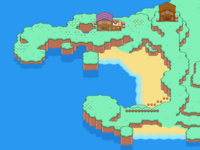
|
- In the original N64 version, Great Scale (オオウロコ村) was another village separate of Tazmily. It was a village occupying a vast inlet, where many villagers would go fishing. Over the course of the game, the two-headed Kraken was to attack the village and attempt to devour Fuel.
- In the final release, Great Scale (re-dubbed "Cerulean Beach" in the fan translation for unknown reasons) is revised to be a small beach within Tazmily, losing its own identity and significance to the plot. The Kraken was cut along with it.
Death Desert
| N64 Version | GBA Version |
|---|---|
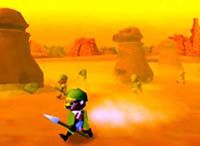
|
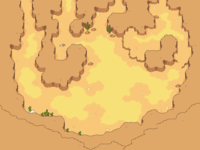
|
- Death Desert was a much larger area in the N64 version. It was far more open, with water holes, tall rocky structures, and small huts that could be found. It had a far more significant role in the story, and in the Spaceworld '99 demo was used as demonstration for the Pork Bean mechanics.
- Death Desert is massively downgraded in the final release. It is a much smaller map, with an oasis at the center of it. It's only ever visited at the beginning of Chapter 3, with the player unable to return to it afterward. The Pork Bean is also introduced after the player leaves the area, thus it's impossible to ride it around the desert as originally planned.
Murasaki Forest
| N64 Version | GBA Version |
|---|---|
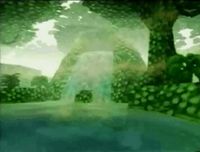
|

|
- In the original N64 version, the Murasaki Forest was originally called "Shimedori Forest" (シメドリの森), Shimedori being a type of Japanese hawfinch. Originally, the area was more akin to a rainforest with Baobab trees, having a dominantly green color scheme.
- The forest was renamed to Murasaki ("Purple") Forest in the final release. Instead of a rainforest, Murasaki become more of a traditional forest with purple trees around the perimeter.
Clayman Factory
| N64 Version | GBA Version |
|---|---|
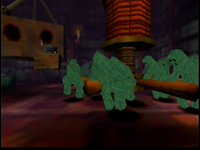
|
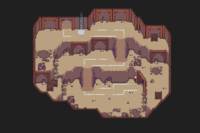
|
- The Clayman Factory was one vertically-enormous map in the N64 version. A lift would transport people from the top floor to the bottom, with rafters at the very top of the building that Lucas can be seen walking on in Spaceworld '97 footage. The building is also quite dark and dismal, with the only source of lighting being from candles on the walls.
- In the final release, the factory is split into multiple smaller maps as opposed to a singular tall map like the N64 version. The lift is still present, escorting the player down to the bottom floor where the claymen work. However, the rafters were removed likely due to the loss of the sense of depth the 3D map originally had. The factory overall is a lot brighter and sleek-looking compared to the dismal atmosphere of the original N64 version.
Club Titiboo
| N64 Version | GBA Version |
|---|---|
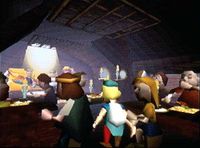
|

|
- Club Titiboo was akin to a "hole-in-the-wall" nightclub in the N64 version. Its layout is far more compact and rustic in appearance, the building being naturally lit by candles on the walls.
- In the final release, Club Titiboo's design is much more inspired by the look of a 1950s diner, complete with red and yellow checkerboard floors. It's far brighter and more colorful in appearance, no longer being naturally lit.
Cut Locations
Spectacular Cave
The Spectacular Cave was a gold mining quarry up in Great Rock which was cut from the final game. It was first mentioned in press material following Shoshinkai '96, with Itoi once conducting a mock report from within the cave in a magazine. Lucas and Claus were meant to ride a minecart through Spectacular Cave in order to escape the forest fire in Chapter 1, but it seems this cave was cut along with that story beat.
Toilette Falls
Toilette Falls was a popular waterfall destination several kilometers east of Tazmily Village that was first introduced in Volume 21 of the MOTHER 3 Times. It was particularly favored by young Tazmilians for its “sublimely romantic and dangerous view” and was where Flint discovered the washed-up Lucas and Claus after they had escaped the Spectacular Cave. In the GBA version, this location was cut along with that plot beat, and the twins are discovered at a riverbank instead.
Honolele Summer Resort
An area named "Honolele Summer Resort" (ホノレレサマーリゾート) was advertised by an NPC on a sign pictured in the image above. This was the only time it was ever mentioned, in a Weekly Famitsu issue in January 1997. It was described as a famous exotic resort that also had the nickname "The City of Lights".
Cutscenes/Events
| To do: Do all of the scenes. |
Chapter 1
Rescuing Lighter Scene
| N64 Version | GBA Version |
|---|---|
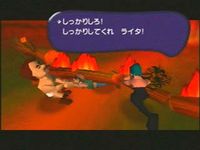
|
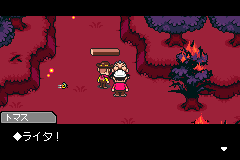
|
- In N64, Lighter is collapsed under a fallen tree in the middle of a path that turns off to the left at the edge of the screen. In the GBA version, he's simply lying on the ground where no pathway is present.
- Jackie and Bronson attempt to help Lighter up. In GBA, only Thomas attempts to help Lighter, while Jackie stays in front of the Yado Inn and Bronson is collapsed from smoke inhalation just outside the forest.
- The line in the N64 screenshot, "Get a grip! Get a grip, Lighter!", is found nowhere in the GBA version.
Cliff Scene
| To do: Put the correction bullet point to each trailer shot. |
| N64 Version | N64 Version | GBA Version |
|---|---|---|
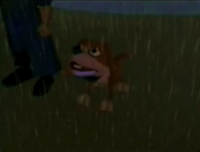
|
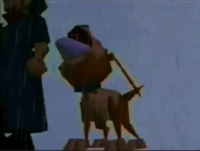
|
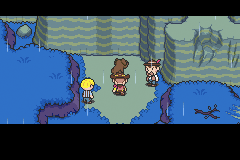
|
- Boney howls directly at the top of the cliff, instead of the top-right like in the GBA version.
- Flint is also standing next to him, whereas he is kneeling directly behind Boney in the GBA version.
| N64 Version | N64 Version | GBA Version |
|---|---|---|
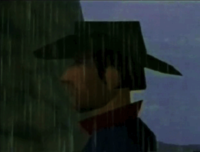
|
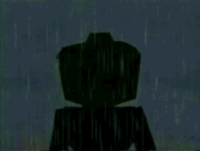
|

|
- Flint stares directly up the cliff, instead of to the top-right like in the GBA version.
- Lucas and Claus were present during the scene. In GBA, they weren't saved yet.
- The top of the cliff was never shown off.
| To do: Get GBA screenshot of Boney rain scene, and put info for each image below. |
| N64 Version | GBA Version |
|---|---|
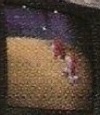
|
[[File:]] |
| N64 Version | GBA Version |
|---|---|
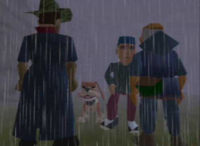
|
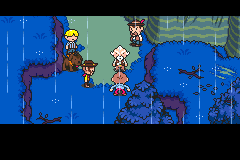
|
- Boney pulled Duster by his leg instead of his shirt.
- Boney and Duster appear together near the end, instead of Boney running forwards towards Flint.
Campfire Scene
To do:
|
One of the cutscenes kept pretty much the same between versions. There exist three versions of this specific cutscene: the N64 version, an earlier iteration of the GBA version, and the final one used in the game.
| N64 Version | Early GBA Version | Final GBA Version |
|---|---|---|
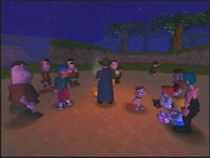
|
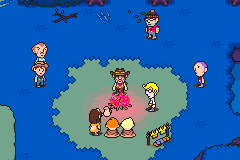
|
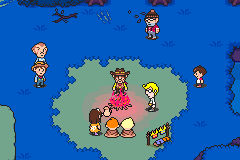
|
- More villagers are present in the N64 version, including Mapson, Mike, Biff (presumably), an unknown villager behind Jackie (possibly Abbot), Boney and Butch. Tessie, Isaac and Fuel are absent. In total, there are at least 12 villagers present, with every other version having 10 villagers present.
- Jackie was originally present in the N64 and earlier GBA version. In the final, he was replaced by Fuel.
- Lucas and Claus are not covered up in a towel/blanket in the N64 version, since they were found earlier in the day.
| N64 Version | Early GBA Version | Final GBA Version |
|---|---|---|
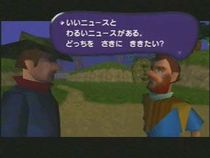
|
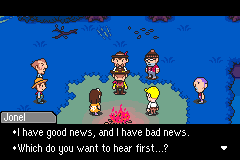
|
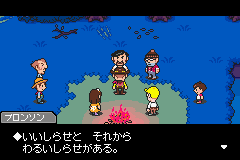
|
- Flint talking to an unknown NPC, hinted to be Jonel as he's present in the earlier GBA version. Final GBA has Bronson instead.
- In the N64 version, the word "news" is used in katakana. In the final version, the word is replaced with its Japanese equivalent "しらせ" (shirase) instead.
| N64 Version | Early GBA Version | Final GBA Version |
|---|---|---|
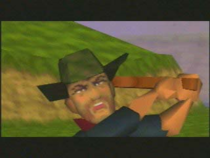
|
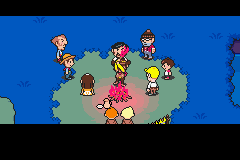
|

|
- The part where Flint having a meltdown after hearing the bad news in the N64 version is very much the same in the GBA version, save for being a close-up and holding it to the left of his head in the original N64 version. In the final release, he holds it straight above his face.
Hinawa Flashback Scene
| To do: Get GBA screenshot of the scene. |
| N64 Version | GBA Version |
|---|---|
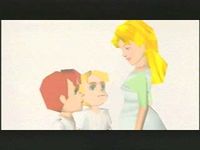
|
[[File:]] |
- The flashback scene of Hinawa after Flint has been knocked unconscious has an all white background in the N64 version, showing Lucas and Claus looking up to Hinawa. It is unknown if Flint or Boney show up for this scene as this is the only publically available screenshot of it.
- In the GBA version, it clearly shows them in front of their house, starting with Flint and Hinawa having a conversation before Lucas and Claus drag Hinawa away, and Flint going inside. The GBA version then switches to an all white background, just like the N64 version, showing Hinawa walking into the afterlife.
Epilogue Scene
| N64 Version | GBA Version |
|---|---|
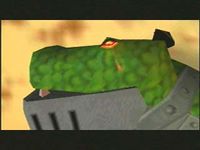
|
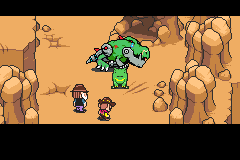
|
- The camera zooms in the Mecha Drago in the N64 version, with the creature facing down to the left. Its teardrop is large and translucent, having an orange outline which barely makes it visible.
- In the GBA version, like most cutscenes, the camera is no longer dynamic and hangs overhead the entire scene. The Mecha Drago instead now lies down to the right, with its teardrop being a solid blue.
Chapter 2
Zombie Battle Scene
| N64 Version | GBA Version |
|---|---|
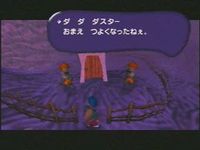
|
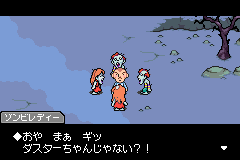
|
- Originally, in the N64 version the zombies rose as Duster approached Nippolyte's shed. As seen in the Spaceworld '99 trailer, the zombies in the N64 version featured mechanical parts on their body, alluding to them being experiments of the Pigmask Army. The two zombies seen in this image have grey metallic visors over their left eyes as well, along with their design resembling the Pseudo Zombies from Mother 1.
- In the final release, the zombies now rise immediately as Duster enters the Sunset Cemetery. The fourth female zombie has a very similar line of dialogue as seen in the N64 screenshot, although it is rephrased slightly. Their designs also moreso resemble Ness and Hinawa rather than the Pseudo Zombies.
Wess Dance Scene
| N64 Version | GBA Version |
|---|---|
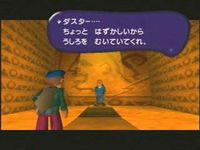
|
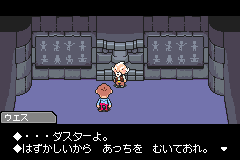
|
- In the N64 version, Wess stands upon a pedestal with a spotlight illuminating him from above, as the camera hangs on Duster's back. The design of the Noble Spittoon room is also painted gold, with strange markings all over the walls. The door has a side profile of a smiling man on it, seemingly with a curly monkey tail beside it.
- In the final release, the room is completely redesigned to be more traditional, with stone padded walls. The strange markings on the walls are replaced with diagrams on how to do the Osohe Dance, with the door now depicting the caricature of a grumpy man. The pedestal and spotlight are also gone, although Wess' dialogue remains nearly identical to the original N64 script.
Meeting Kumatora Scene
| N64 Version | GBA Version |
|---|---|
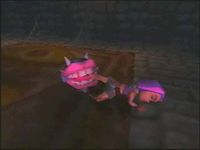
|
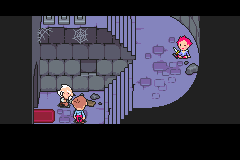
|
- This screenshot in the N64 version remains a mystery. Although it is clearly Kumatora with her leg caught in the trap (with the trap itself resembling a twisted depiction of "Gag Teeth"), it is unknown if this is truly a cutscene or not. Mother 3 typically goes into widescreen format for cutscenes, having black bars crop the top and bottom of the screen. That is not the case here - so either it's frames before the bars appear, or perhaps this might be a first-person camera.
- In the final release, Kumatora is found crouched in the middle of the stairway as opposed to being fallen over in the middle of an open room. The trap is also redesigned to be a typical bear trap.
Washed Ashore
| To do: Fix GBA screenshots of scene. |
| N64 Version | GBA Version #1 | GBA Version #2 |
|---|---|---|

|
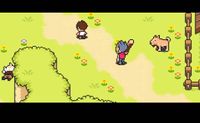
|
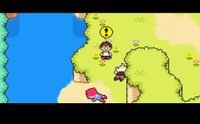
|
- In the original N64 version, the camera is focused on a three-quarter view of Lighter and Fuel walking by. They both turn their heads as they notice something, with exclamation marks both appearing above their head. Since the camera is focused on them, we're not directly shown what they are seeing.
- In the first screenshot of the GBA version, we see this has been changed to the camera following Lighter and Fuel from behind. Fuel now runs ahead of Lighter, and off to the side Wess can now be seen lying on unconscious.
- In the second screenshot, we see Fuel now returns to the scene by himself to find the party lying unconscious. Although the exclamation mark still appears, Fuel now runs back to fetch Lighter and show him the discovery.
Chapter 3
Desert Arrival Scene
| N64 Version | GBA Version |
|---|---|
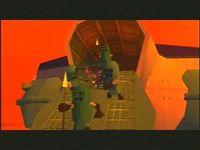
|
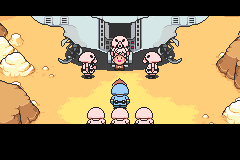
|
- Salsa and Samba are caged up together instead of being separated and not in a cage. It is also sunset in the N64 version, and only Pigmask Sergeants seem to be present.
- In the GBA version, it is the middle of the day and a Pigmask Captain is also present.
Salsa Getting Shocked
| To do: Fix GBA image. |
| N64 Version | GBA Version |
|---|---|
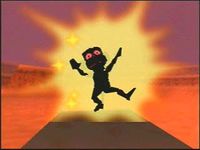
|

|
- In the N64 version, when Salsa gets electrocuted, Fassad is off-screen. Instead of Salsa's outline being illuminated like in the GBA version, Salsa's electrocution is instead represented with a yellow flash of light behind an electrified Salsa in the N64 version.
- It is also sunset in the N64 version, rather than the middle of the day like in the GBA version.
Happy Sales Scene
| N64 Version | GBA Version |
|---|---|
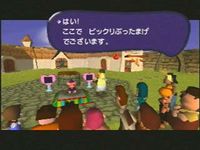
|
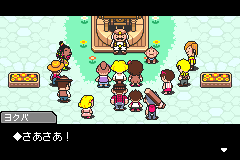
|
- A platform is present in the N64 version, which is not found in the GBA version.
- Two Happy Boxes are present near Salsa and Fassad. They're nowhere to be found in the final.
- The well is boarded up in the N64 version.
- Elmore and Mike are present in the crowd in the N64 version. In the GBA version, they are nowhere to be found.
Box Delivery Scene
| N64 Version | GBA Version |
|---|---|
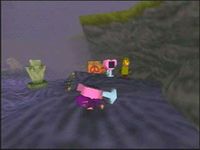
|

|
- A Pigmask Private is located near the boxes instead of Mapson.
- While there are boxes, there are also TVs outside of those boxes.
- Salsa carries the TVs instead of the boxes.
- The boxes have the Pigmask insignia on them instead of hearts.
Tank Boss
| N64 Version | GBA Version |
|---|---|

|

|
- An unknown Pigmask vehicle is present along with the tank. There is no equivalent vehicle in the GBA version.
- There are two enemies present in the fight in N64. GBA only has the boss itself.
- Salsa was originally the only regular party member in the fight. In GBA, Kumatora is there as well.
- The Drago Child is helping during the fight in N64 as a guest party member. In GBA, the Drago Child appears after the fight, with Wess being the only guest party member in the battle.
- Unused GBA data points to the location of the battle being originally located where the Campfire was (which matches up with the floor of the N64 screenshot). In GBA, the battle takes place in the middle of the Sunshine Forest.
Chapters 4 and 5
| To do: Fix GBA image. |
Lucas Infiltrating Clayman Factory
| N64 Version | GBA Version |
|---|---|

|
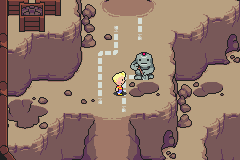
|
- While Lucas infiltrates the Clayman Factory from the rafters in the N64 version, he instead infiltrates the factory on its ground floor in the GBA version. This was most likely done to accommodate the difference in the location's structure between the two versions.
D.C.M.C. Concert
| N64 Version | GBA Version |
|---|---|
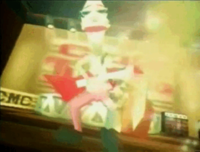
|
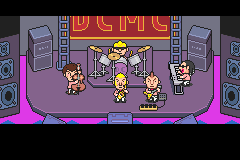
|
- The formation of the D.C.M.C. seems to be flipped between the two versions.
- The poster in the back says "Club Titiboo D.C.M.C." in N64, with it simply saying "DCMC" in the GBA version.
- The drum says "D.C.M.C." instead of "DC".
- The audience is filled with Pigmasks.
Thunder Tower Porkship
| N64 Version | GBA Version |
|---|---|

|
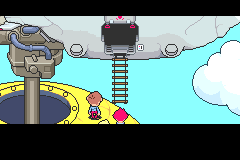
|
- They're inside a domed room at the top of the tower, instead of on the roof of it.
- Flint is present in this scene instead of Kumatora. There are unused graphics still found in the GBA version.
- Duster is grabbing on from the side instead of using the Rope Snake. There are unused graphics of Duster using rope in the GBA version.
| N64 Version | Early GBA Version (Mockup) | Final GBA Version |
|---|---|---|

|
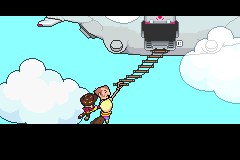
|

|
- The gang are not all holding on to Duster in N64. They're separate in two equal groups.
- Lucas is grabbing on to Flint instead of Duster.
- Boney is grabbing on to Duster instead of Lucas.
Chapters 7 and 8
| To do: fix GBA destruction images. |
The Dark Dragon's Awakening
| N64 Version | GBA Version |
|---|---|
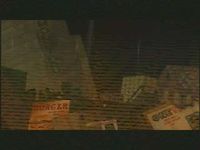
|
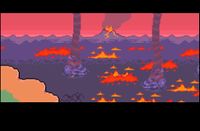
|
- The Dark Dragon's awakening has a more dismal atmosphere in the N64 version. The sky is nearly pitch black, with small tornadoes swirling in the background. Familiar iconography such as the Monotoli Building and Onett news sign can be seen crumbling to the ground. This location is probably Tazmily Village after its modernization (as another screenshot shows it was remodeled to look much like Onett), or New Pork City.
- The first GBA screenshot shows tornadoes in the sky, which are also present in the N64 version. However, no buildings are nearby as the camera pans across Mt. Oriander. The sky is also no longer pitch-black as it was on N64, but a deep sunset.
| N64 Version | GBA Version #1 | GBA Version #2 |
|---|---|---|
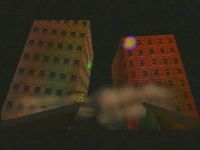
|
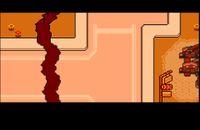
|
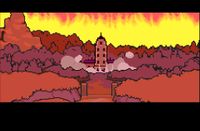
|
- Two buildings can be seen leaning towards each other and falling as the ground below splits open and collapses in the N64 version. Dust can be seen rising as the buildings crumble towards the ground.
- The first GBA screenshot shows the ground splitting apart just like in the N64 version. However, no collateral damage from buildings nearby is shown.
- The second GBA screenshot shows Osohe Castle collapsing in a very similar fashion to the buildings in the N64 version, complete with dust formation.
References
- ↑ Spaceworld '99 Booklet - Nintendo of Japan, August 27th, 1999
- ↑ Early "F-F-Fire!" Cutscene - Lorenzooone, Feb 24, 2019
- ↑ Feelings of MOTHER 3 - Hobonichi, April 28th, 2006
- ↑ 4.0 4.1 Shigesato Itoi Talks All about MOTHER 3 - Nintendo Dream, July 2006
- ↑ MOTHER 3 Was So Difficult to Make I Can't Even Think about "4" - 64 Dream, May 2000
- ↑ All of the Lines Are Written By Itoi... - 64 Dream, November 1999
- ↑ EXCELSIOR MOTHER 3 Spaceworld Demo Report - Nintendo Spaceworld '99, August 27th 1999
- ↑ MOTHER 3i Liner Notes - November 21st, 2006
- ↑ Mother 3 (N64) - Minecart Scene - chasqui06, Mar 29, 2022
- ↑ MOTHER 3 Maniac Quiz - 1101.com, 2007
- ↑ MOTHER 3 N64 Characters - MOTHER FOREVER
- ↑ Space World '97 - The Cutting Room Floor
- ↑ https://starmen.net/eb64/publications/Famitsu_Issue_31_January_1997_PG4.jpg
Index
Mother 3 prerelease timeline
| |
|---|---|
| Overview | Differences |
| Nintendo 64 version | Early N64 Development • 1996 • 1997 • 1998 • 1999 • 2000 |
| Game Boy Advance version | Early GBA Development • 2001-2002 • 2003-2004 • 2005 • 2006 |

